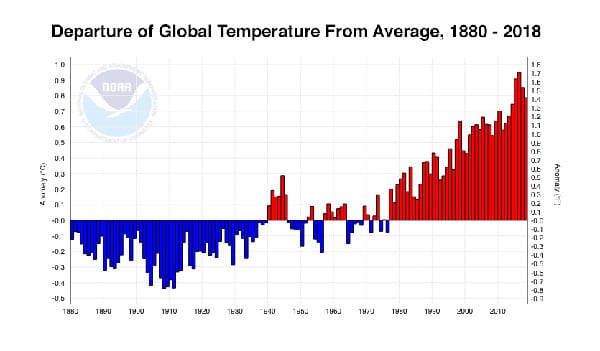
February 6, 2019; New York Times
Records show that the earth in 2018 had its fourth-highest average surface temperature in almost 140 years, according to the announcement last week by NASA scientists. Tracking the data shows a clear and persistent upward trend over 14 decades. According to the history as documented, the five warmest years have been the last five years. Since 2001, the planet has undergone 18 of the 19 warmest.
The long, 140-year journey up to our current temperatures has sped up in the last 20 years, confirming the scientific consensus that human activity is causing the uptick. It is this most recent period, and its record rise in levels of carbon dioxide and methane, which confirms that it is no longer “tomorrow” that is of concern.
“We’re no longer talking about a situation where global warming is something in the future,” said Gavin A. Schmidt, director of the Goddard Institute for Space Studies, the NASA group that conducted the analysis. “It’s here. It’s now.”
NASA’s temperature data and that of the National Oceanic and Atmospheric Administration, or NOAA, came out together. (This year’s global temperature reports were delayed, as scientists from NOAA and NASA were prevented from completing the analysis of the data by the government shutdown.) They use marginally different procedures to calculate the overall temperature changes and have disagreed once or twice on rankings by a year, but both agree that 2018 was the fourth-warmest year.
Scientists caution that to avoid the worst consequences, the earth’s overall temperature cannot rise over 2 degrees Celsius from where it was in the beginning years of the Industrial Revolution. Measuring from that 19th century mark to 2018, the earth is now registering over 1°C higher.
The report provides nonprofits with red flags and warning signs, relating to the work they are doing, and how they may have to change. Nonprofit Quarterly has written on how climate change will affect nonprofits—public health concerns; how the ability to get food globally will be affected by drought in some places and floods in others; and a possible increase in refugees escaping harsh conditions. Nonprofits are already including climate change in their missions as they deal with coastal flooding in the United States from destructive hurricanes like Florence and Michael and shrinking Arctic ice and mountain glaciers. The polar vortex pushed Midwest communities to close colleges and schools for days at a time. And, in the rebuilding of Puerto Rico after 2017’s hurricane, attention is being paid to resilience.
Sign up for our free newsletters
Subscribe to NPQ's newsletters to have our top stories delivered directly to your inbox.
By signing up, you agree to our privacy policy and terms of use, and to receive messages from NPQ and our partners.
Returning to the Times…
In addition to the fourth warmest year on record, 2018 was also the fourth-costliest for weather disasters in the United States. Last year’s total was $91 billion, less than 2017, when disasters inflicted a record breaking $306 billion of damage. But it reflects a broader trend of more frequent and intense extreme weather events including hurricanes, floods, droughts and wildfires that scientists say are to be expected with a warming climate. According to NOAA, 2018 was the first time on record when wildfires have exceeded average hurricane costs in the United States.
Dr. Schmidt speaks of a downhill slide that the earth is on, rather than a sudden crisis cliff. Scientists believe it can still be slowed with great effort, and perhaps reversed over time. From the data gathered, though, the 2-degree line will be crossed even with over 190 countries participating in lowering the greenhouse emissions through the Paris Climate Agreement. Even half a degree more will have calamitous consequences.
The journal, Nature, published two new studies which propose that the melting polar ice caps could bring more punishing weather. Tamsin L. Edwards, a climate scientist at King’s College London and leader on the first study, which is focused on the impact of Antarctic ice-shelf collapse, estimates that the sea level rise would be near 10 inches, and predicts 5 to 6 feet in 80 years—just a lifetime.
In the other study, Nicholas Golledge, associate professor at Victoria University of Wellington’s Antarctic Research Centre in New Zealand, demonstrates that fresh water sloughing off of Greenland’s melting will affect the Atlantic Ocean’s circulation, bringing warmer water to hurricane alley’s Gulf of Mexico.
“People say, ‘How do we know the science is any good? How do we trust the models? They’re so complex!’” But, Dr. Golledge said, “That’s the essence of science. You think you understand how something works, you make models and you make predictions and see if they come true. Unfortunately, we’re in a situation where we see it’s come true.”—Marian Conway











